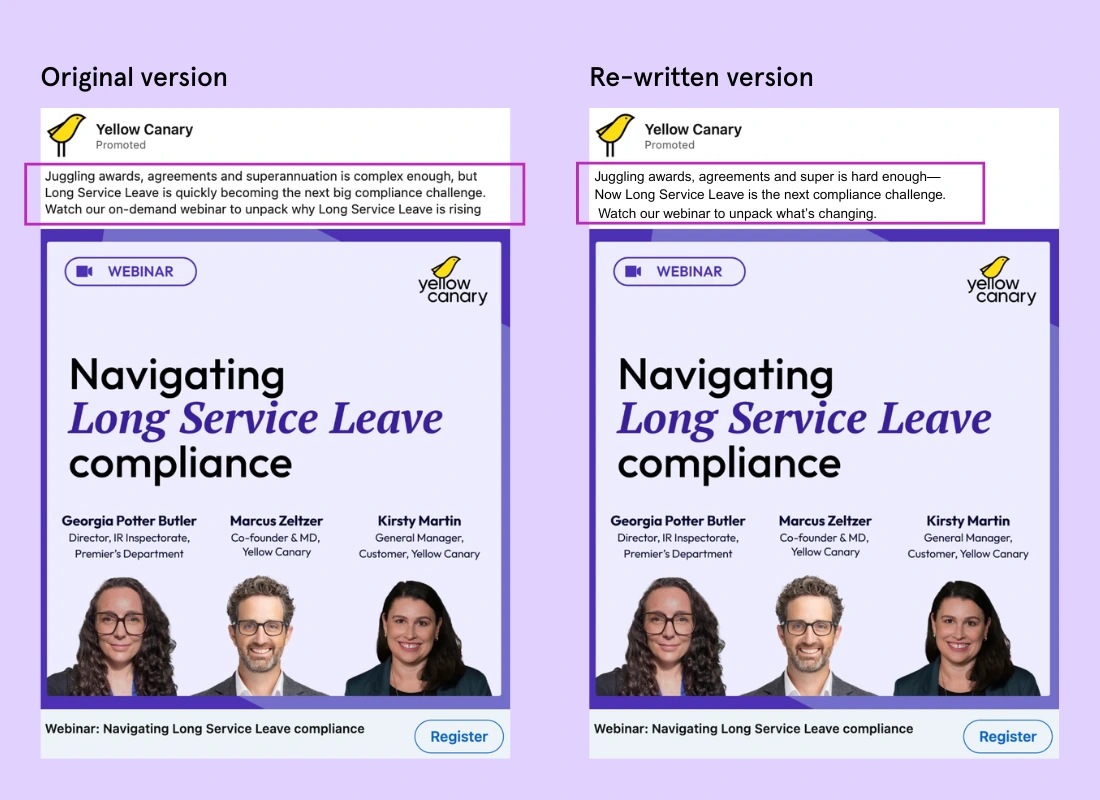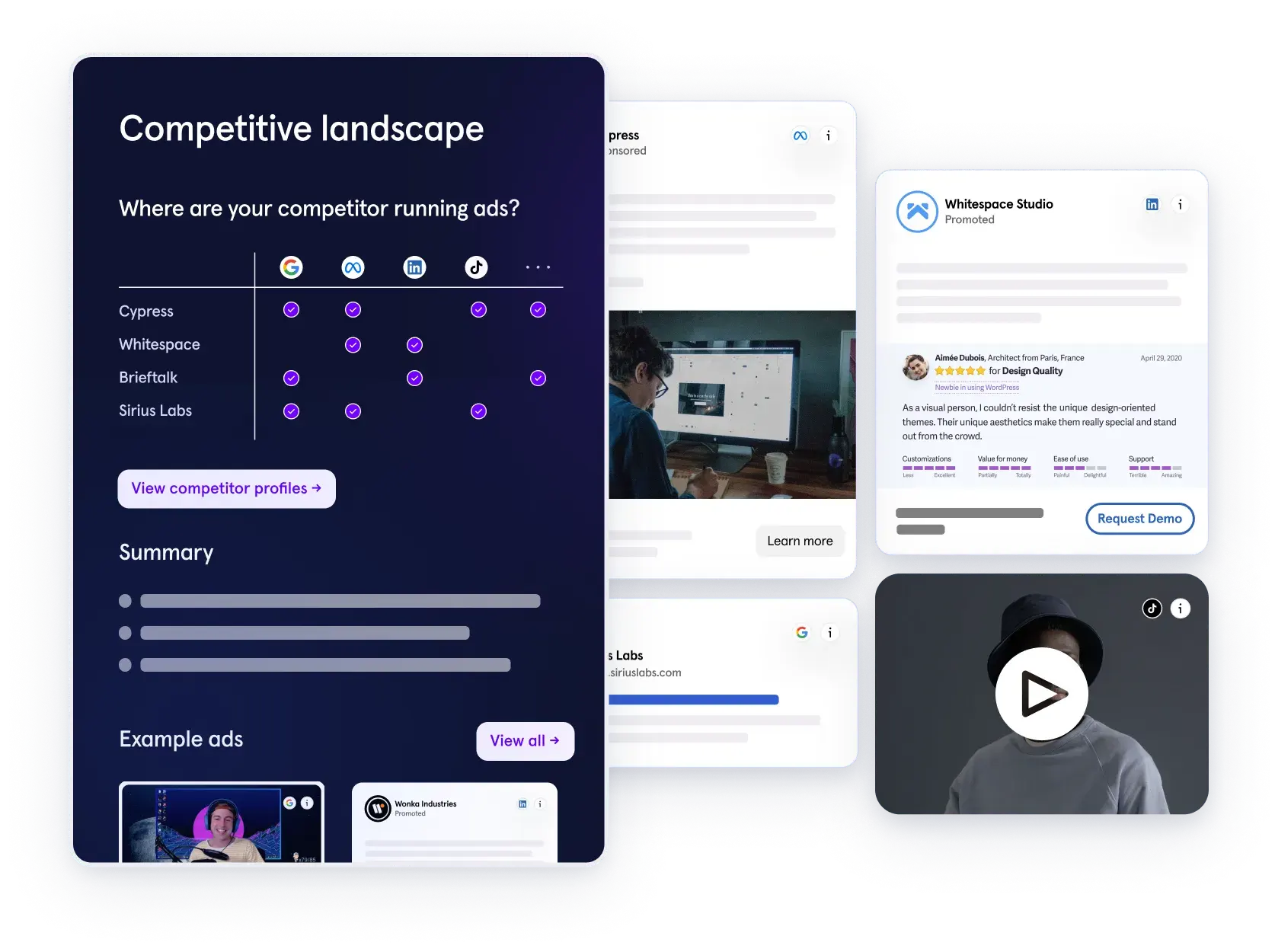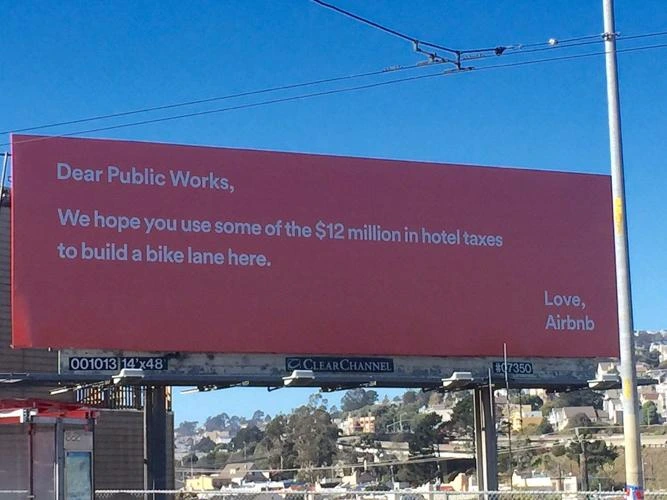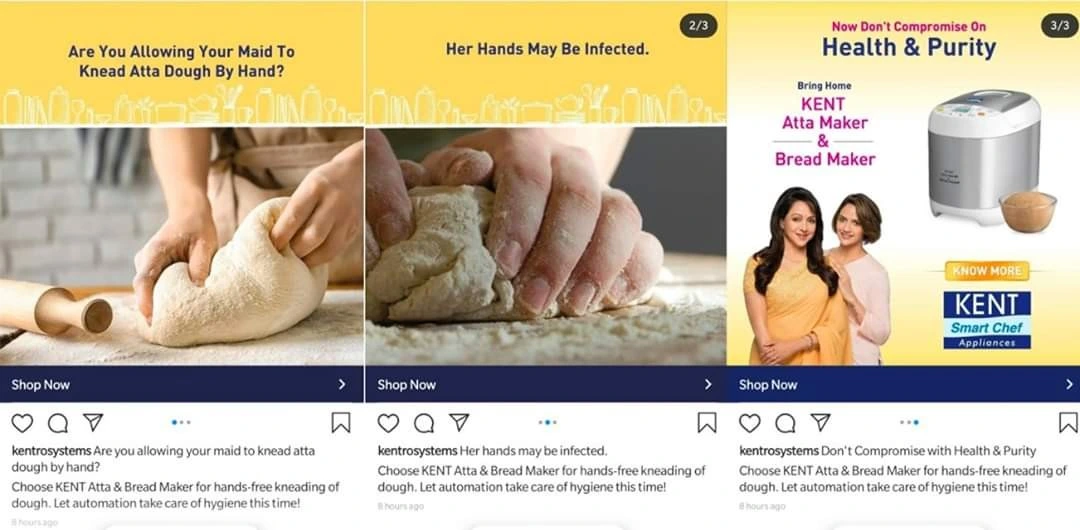There’s an uncomfortable truth in advertising that almost no one talks about.
Your targeting can be flawless, your design can be eye-catching, your funnel can be airtight… and your campaign can still flop.
Why? It almost always comes down to the copy.
Ad copy is the bridge between your product and your customer. In a sea of competing messages, it must do the impossible: stop the scroll, hold attention, spark interest, and drive action, all within seconds.
If you’ve ever poured hours into writing an ad, only to watch it flop, you are not alone. We have seen this happen even with some of the smartest startup founders and marketers we know. Ad copywriting feels deceptively simple. After all, how hard can writing a few lines be, right? But the truth is, those “few lines” carry a lot of weight. They are responsible for grabbing attention, communicating value, and nudging someone to take action.
The painful reality is most ad copy fails. It gets scrolled past, ignored, or worse, annoys the audience. And we get why. There is so much to juggle: messaging, tone, audience insights, product benefits, design, and of course, a tight character limit.
That’s exactly why we wrote this guide. We want to walk you through the top 10 ad copywriting mistakes that we see over and over again. These are the mistakes that silently kill performance and waste precious ad budgets.
But we are not going to just list them out. We will also show you bad copywriting examples, explain why they fail, and give you simple, actionable fixes you can apply right away.
Whether you are running Facebook ads, Google Search campaigns, LinkedIn ads, or even display banners, this guide will help you tighten your copy, avoid the usual traps, and actually write words that sell.
So let’s start from the basics first.
11 ad copywriting mistakes at a glance
- Not researching competitor ads makes your copy blend in and miss proven angles.
- Lack of clarity confuses readers and kills attention in seconds.
- Ignoring your USP leaves prospects with no reason to choose you.
- Writing for everyone results in vague, forgettable messaging.
- Weak or missing CTAs leave users unsure of what to do next.
- Using jargon or complex language overwhelms and alienates readers.
- Relying on clichés makes your copy sound lazy and unoriginal.
- Focusing on your brand instead of the customer loses relevance.
- Poor formatting makes your ad hard to scan and easy to skip.
- Sounding too pushy turns off modern, skeptical audiences.
- Skipping proofreading hurts credibility with simple, avoidable errors.
What is copywriting?
Copywriting is the art and science of writing words that persuade someone to take a specific action. That action could be clicking on an ad, signing up for a free trial, making a purchase, booking a demo, or even just reading more.
A copywriter’s job is to combine creativity with strategy. It is not about being poetic or clever just for the sake of it. Effective copywriting speaks directly to the reader’s pain points and desires, while gently guiding them toward the solution: you.
What is ad copywriting?
To simply put: it’s just copywriting but for ads.
In the context of paid advertising, copywriting has even more pressure. You have very little time and space to get the job done. You must hook attention fast, spark interest, and make the next step feel irresistible — all within a few words.
Good copywriting has a formula = clear + concise + compelling + credible + conversational. These are known as the 5 C’s of copywriting. And when your copy has all these Cs, you know you’re up for success.
When your ad copy works, you will know it. Clicks go up, conversions rise, and your cost per acquisition drops. That’s why learning how to avoid copywriting mistakes is one of the most valuable skills you can develop as a founder or marketer.
What are the most common copywriting mistakes?
We’ve audited hundreds of ad campaigns for clients across industries, and the pattern is always the same. You can have flawless audience targeting, and stunning creative assets, and still see your campaigns underperform.
The root cause, at least 90% of the time, is the ad copy.
Ad copy is often misunderstood. Many founders and marketers treat it as an afterthought i.e., just a few lines to describe the product. But in reality, ad copy has an enormous responsibility. It must stop the scroll, capture attention, communicate your unique value, inspire action, and do it all within seconds.
This is why even small copywriting mistakes can completely derail campaign performance. But the good news is that these mistakes are predictable and fixable. We’re going to walk you through the 10 most common ad copy mistakes we see, why they happen, how they hurt performance, and exactly what you can do to avoid them.
1. Not researching competitor ad copy
One of the most overlooked mistakes we see in paid media strategy is failing to analyze what your competitors are saying. Many brands craft ads from scratch, focusing only on their own product benefits or messaging. While that feels safe, it almost guarantees you’ll sound similar to everyone else in your space — or worse, completely miss what actually works for your audience.
Why it happens:
Founders and marketers often assume that because they know their product inside out, they know the best way to sell it. Or, they simply don’t have the time or tools to study competitive messaging before launching their own campaigns.
The impact:
Without competitor research, brands waste time and budget testing copy angles that competitors have already proven don’t work. They might even duplicate overused messaging that the market has long since tuned out. This results in poor differentiation, lower click-through rates, and a higher cost per acquisition (CPA).
You also risk missing critical insights like:
- The type of emotional or rational appeals competitors are using
- Offer structures and calls-to-action that are resonating
- Gaps where competitors are not effectively positioning themselves (giving you an opportunity)
The fix:
Always conduct competitor ad research before writing your paid copy. A good competitor ad analysis and research tool can give you clear visibility into your competitor landscape. You can analyze real-time ad examples, landing pages, offer positioning, tone of voice, and even which ads have been running the longest (a signal that they perform well).
With this data, you can create ad copy that differentiates your brand, avoids copycat pitfalls, and confidently doubles down on angles that work. It transforms your copywriting from guesswork into a strategy built on real competitive intelligence.
2. Lack of clarity
We cannot emphasize this enough: your ad copy must be crystal clear at first glance. You only get a second or two before someone scrolls past. Vague statements like "Unlock endless possibilities with our innovative platform." leave readers puzzled.
What exactly are you offering? What does this “platform” do? Who is it for? How will it help me? The reader has to work to figure it out, and nobody puts effort into decoding an ad. They simply move on.
The impact: Ads with unclear messaging consistently get low click-through rates (CTR), poor Quality Scores, and high costs per click (CPC). Platforms like Google and Meta reward clarity because clear ads drive better engagement.
The fix: Always be specific and outcome-driven. State the benefit in plain language. Here’s an example: "Automate your accounting and save 10+ hours per week."
This tells the reader exactly what they’ll get and why they should care. This should bring you higher CTR, better relevance scores, and lower CPC.
3. Ignoring your unique selling point (USP)
A shocking number of ads completely miss this. Brands write safe, generic lines like: "The best CRM software for your business."
But it has a problem: every CRM claims to be the best. If your ad sounds like everyone else’s, you instantly disappear into the noise. Prospects cannot distinguish you from alternatives, so they scroll past.
The impact: Low differentiation leads to wasted ad spend. Even if you have a superior product, you lose opportunities because you didn’t tell your audience why you’re different.
The fix: Lead with your “why us” advantage. Highlight something only your product can offer. For example: "The only CRM with built-in AI to write your sales follow-up emails automatically."
This makes the audience stop and think, “I haven’t seen that before.” A strong USP increases brand recall, improves ad engagement, and positions you ahead of competitors.
4. Writing for everyone
Many early-stage startups fall into this trap. They want to “cast a wide net” by appealing to every possible audience. The result is copy like this:
"Our tool helps businesses of all sizes grow."
This seems safe, but it is completely ineffective. No audience can see themselves in this statement. It feels cold and disconnected.
The impact: Low relevance leads to low engagement and extremely high cost-per-click because people don’t believe the message was meant for them. General messages perform poorly in paid media environments.
The fix: Focus your copy on one specific persona and pain point. Here’s an example: "Solopreneurs: Save 4 hours a day automating client proposals with our tool."
This approach makes the reader feel like you understand their struggle. When your prospect feels seen, engagement and conversion rates dramatically improve.
5. Weak or missing call-to-action (CTA)
You can write perfect copy, but if you don’t guide the reader on what to do next, they will hesitate and scroll away. Many brands write weak CTAs like: "Discover our platform." But it feels passive and unclear. What does “discover” mean? Where does it take me? Why should I do it now?
The impact: Poor or missing CTAs cause even high-intent users to abandon the ad journey. You lose valuable clicks simply because people weren’t told what to do.
The fix: Always give a clear, specific, and actionable next step. Strong CTAs reduce decision fatigue. For example: "Start your free 14-day trial today." or "Book your free demo and see how it works."
These tell the reader exactly what happens next, reducing friction and massively improving conversion rates.
6. Using jargon or overly complex language
We see this mistake often with SaaS, tech, and B2B companies. Founders and marketers get so immersed in internal terminology that they forget their prospects may have no idea what these words mean. Here’s an example of such copywriting: "Leverage an omnichannel, cloud-native infrastructure to optimize workflows."
This kind of language creates confusion. People will not pause to figure it out, they will simply keep scrolling.
The impact: Cognitive friction reduces reading time and kills engagement. If a prospect doesn’t understand your offer in seconds, your campaign fails.
The fix: Simplify. Use plain language that your audience can instantly understand. For example: "Manage all your customer support from one simple dashboard."
Remember, clarity always outperforms cleverness. Simpler copy consistently leads to higher CTR and improved ad performance.
7. Relying on clichés and overused phrases
We’ve seen countless ads that say: "Our revolutionary, game-changing solution will transform your business."
These phrases are so overused that they are completely ignored. They no longer carry any real meaning and are treated as noise by readers.
The impact: Over-reliance on hype language reduces trust and credibility. Because these tones are so abundant, the audience becomes desensitized to these empty promises and stops paying attention.
The fix: Drop the buzzwords and be direct about your value proposition. Instead, show the result you deliver. For example: "Double your email open rates in 7 days, guaranteed."
Specific numbers and outcomes always feel more believable and actionable, leading to better performance.
8. Focusing on the brand, not the customer
Many founders write ad copy about themselves: "We’ve spent 3 years building our award-winning AI algorithm with a team of 50 engineers."
While impressive, this means nothing to your prospect. They only care about what your product will do for them.
The impact: Copy that talks about your company, instead of the customer’s pain points, results in extremely poor engagement and click-through rates.
The fix: Always shift your focus to outcomes and results the customer will experience. For example: "Cut customer churn by 40% using our AI-powered customer behavior alerts."
This style of copy tells the reader exactly how their life or business will improve with your product. That’s what drives action.
9. Poor formatting and readability
Paid ads must be scanned quickly. But many companies still write huge blocks of dense text like the caption of the ad in original version aka the first image.
This can overwhelm the reader and as a result, might get ignored.
The impact: Unreadable ads lead to poor ad quality scores, low engagement rates, and wasted spend.
The fix: Structure your copy for scannability. Use bullet points, line breaks, and short sentences. For example, check the caption in the second image. Well-formatted copy holds attention, boosts reading time, and increases click-throughs.

10. Sounding too pushy or salesy
We’ve all seen the old-school hard sell approach: "Buy now or miss out forever!"
While this might work sometimes in terms of urging the audience to take immediate action, this can also trigger skepticism and resistance. Modern audiences, especially in B2B and SaaS, do not respond well to aggressive or manipulative tactics.
The impact: Audiences lose trust and avoid your brand altogether. Conversions plummet because the approach feels desperate.
The fix: Lead with value, not pressure. For example: "See how our platform helps agencies increase revenue by 25% in 30 days."
This is persuasive but respectful. It presents clear benefits and lets the user choose. Value-led CTAs always perform better in today’s market.
11. Not proofreading your copy
It may seem minor, but typos and grammar errors absolutely destroy your brand credibility. We’ve seen real ads with mistakes like: "Try are product risk-free!"
Even if the offer is great, errors like this instantly tell a customer you lack attention to detail.
The impact: Loss of trust leads to fewer conversions and lower quality scores. Your competitors win by simply appearing more professional.
The fix: Always proofread your ads. Use grammar and spellcheck tools, and have a second person review your copy before publishing.
Here’s the fixed version of the example:
"Try our product risk-free!"
A polished, error-free ad improves brand perception and protects your hard-earned reputation.
Best tools to research competitor ad copy
Once you understand how critical it is to study competitor ads before writing your own, the next question becomes: How?
Luckily, there are some excellent tools, both free and paid, that let you analyze your competitor’s ad strategies, copy angles, and offers. This insight helps you avoid copywriting mistakes, refine your messaging, and spot gaps where your brand can stand out.
Free tools
These free resources offer valuable starting points for basic competitor ad research:
1. Meta Ad Library
Search any brand running paid Facebook and Instagram ads. You can view live ad copy, creative formats, and landing pages. It’s the simplest way to study how competitors position themselves on Meta platforms.
2. Google Ads Transparency Center
Recently launched, this tool allows you to see live search and YouTube ads from any brand running Google Ads. It’s perfect for reviewing copy and offering trends in your niche.
3. TikTok Ad Library
TikTok Ad Library lets you view TikTok ads from any competitor. You can analyze tone, call-to-action wording, and the creative trends that perform well in your category.
4. LinkedIn Ad Library
While not a formal library, you can visit any LinkedIn company page and explore their recent ad activity. It’s especially useful for B2B competitor research.
Paid tools
Free tools are great for surface-level exploration, but if you want deeper insights—such as ad durations, traffic estimates, creative testing patterns, and landing page flows—investing in a paid tool is essential.
1. Competitor Ad Intelligence Tool (COIN) by Kaya
If you’re still screenshotting ads, hopping between Meta’s ad library and Google’s transparency center, or guessing where your competitors are spending, you’re wasting time you could be using to scale.
Kaya’s Competitor Intelligence platform is purpose-built for paid media teams and founders who want to write smarter copy, not just faster. It gives you an upper hand by helping you deeply understand how competitors are approaching paid ads across Google, Meta, LinkedIn, TikTok, and Bing.
Here’s what you can do with Kaya:
- Research competitor paid ads across major platforms in one place
- Track where competitors are putting most of their ad efforts
- Analyze creative formats, messaging angles, and offer tests
Instead of bloated dashboards or tools trying to do too much, COIN by Kaya is built specifically to deliver what actually matters. It turns competitive insights into a copywriting advantage, helping you differentiate your messaging, avoid saturated angles, and write ads that punch above your spend. It will help you stay ahead of competitors by showing exactly how they run their ads.

Competitor Ad Intelligence Tool (COIN) by Kaya
2. Similarweb
Similarweb helps analyze website traffic patterns and ad placement strategies of competitors. Good for high-level media buying research. It also uncovers where your competitors are getting the most traffic from both paid and organic.
3. Adbeat
Adbeat focuses on display advertising competitive research. It shows you which networks, publishers, and creative formats your competitors are buying into. Ideal for tracking banner ad trends and understanding long-term display spend patterns.
4. SpyFu
Best known for analyzing Google Ads copy, keyword strategy, and search ad history for competitor brands. Spyfu is quite useful for identifying profitable keywords and seeing how long specific ad creatives have been running.
Examples of bad ad copywriting
So far, we’ve talked about the theory of bad copywriting. But to truly understand how even the world’s biggest brands can slip up, it helps to look at real-world examples. These five case studies are not shared to criticize, but to remind all of u how easy it is to misfire when crafting ad messaging. The common theme among all these bad copywriting examples is that a single line of copy can cause enormous backlash, confusion, or loss of credibility.
Here are five powerful lessons you can learn from real bad copywriting mistakes.
1. Airbnb’s tone-deaf billboard campaign
In 2015, Airbnb launched a series of outdoor billboards in San Francisco with statements like:
“Dear Public Works, We hope you use some of the $12 million in hotel taxes to build a bike lane here. Love, Airbnb.”
At first glance, it was intended to be playful and tongue-in-cheek about the taxes Airbnb paid the city. Unfortunately, the public and media saw it very differently. It was perceived as smug, condescending, and insensitive to vital public services.
Why it failed: Airbnb forgot to consider how their audience i.e., the general public, not internal stakeholders would interpret the message. In a city struggling with rising housing costs and corporate friction, this “humor” felt more like corporate arrogance.
The lesson: Always consider the broader emotional and societal context of your copy. What feels clever in a brainstorming session can sound offensive in public. Humility and empathy should always guide brand communication.

Airbnb’s tone-deaf billboard campaign
2. Lexus’ “Experience Amazing” tagline
Lexus, the luxury car brand, has long been admired for its vehicles and engineering quality. However, its “Experience Amazing” tagline missed the mark. The line faded into the sea of overused corporate slogans. It neither increased brand differentiation nor helped Lexus articulate why it stood apart from competitors like BMW, Mercedes, or Audi.
Why it failed: The phrase sounds inspiring but is completely generic. What does “amazing” mean? How is Lexus defining that experience? There was no specificity, no tangible promise, and no connection to the product’s core value.
The lesson: Vagueness is the enemy of great copy. If your tagline could be used by almost any brand in any industry, it’s not strong enough. Great copy must communicate exactly what makes you different, special, and valuable to your audience.

Lexus’ “Experience Amazing” tagline
3. Dr Pepper’s grammatical misstep
Dr Pepper once ran a digital campaign with an ad that contained a glaring grammatical error. Though the mistake itself was minor, audiences noticed it immediately and social media did the rest. It damaged their credibility, even temporarily, and distracted attention away from the actual product offer.
Why it failed: When a global brand makes a basic grammatical error, it comes across as lazy and unprofessional. Customers don’t separate “it’s just a typo” from the bigger picture. They associate sloppy copy with sloppy business practices.
The lesson: Always proofread. Copy mistakes, especially grammatical ones, damage brand trust faster than almost any other error. Readers expect more from well-known brands, and even one small typo can result in disproportionate reputational damage.
4. Kent RO’s insensitive COVID-19 ad
During the height of COVID-19 fears, water purifier brand Kent RO released an ad promoting their automatic bread-making machine. The copy implied that letting domestic workers knead the dough by hand could spread the virus:
“Are you allowing your maid to knead atta dough by hand? Choose KENT Atta & Bread Maker for hands-free kneading of dough. Let automation take care of hygiene this time!”
The backlash was immediate and intense. Kent RO faced massive outrage across social media, with customers calling for boycotts and regulatory bodies issuing warnings. The company was forced to issue a public apology.
Why it failed: The ad was called out for being classist, discriminatory, and in extremely poor taste. It implied domestic workers were dangerous, which was offensive and deeply problematic in a country like India where millions of households rely on domestic help.
The lesson: Empathy and ethics must guide every word you write. In moments of crisis, brands have an even greater responsibility to avoid fear-mongering or exploiting human vulnerabilities. Sensitivity should always outweigh sales tactics.

Kent RO’s insensitive COVID-19 ad
5. Deliveroo’s grammatically awkward slogan: “Eat More Amazing”
Deliveroo, the global food delivery brand, launched a campaign with the line:
"Eat More Amazing."
Rather than driving appetite or excitement, the copy is distracted from the product itself. It sparked grammar critiques online and became a reminder of how easily clever wordplay can backfire.
Why it failed: The intention was clear: associate Deliveroo with outstanding food experiences. But the slogan awkwardly uses “amazing” as a noun, which it is not. The result is a clunky, confusing message that leaves people scratching their heads.
The lesson: Clarity always wins. You can be creative, but never at the cost of proper structure and grammar. Cleverness should enhance your message, not confuse it. Always test your copy with real users before launch.

Deliveroo’s grammatically awkward slogan: “Eat More Amazing”
Why most ad copy fails
Even with the best intentions, most paid ad copy underperforms. We’ve analyzed hundreds of campaigns and consistently see the same reasons why copy fails to convert. Understanding these pitfalls can help you avoid them in your next campaign.
1. Lack of audience understanding
Many brands write what they want to say, not what their audience needs to hear. This disconnect makes ads feel irrelevant. The more you know your customer’s pain points, language, and goals, the better your copy will resonate.
2. Focusing on features, not benefits
A common mistake is listing product features without explaining how they help the customer. Features inform; benefits persuade.
Example: Instead of “Our tool has real-time data syncing,” say “Get instant updates without manual work.”
3. Overcomplicating the message
Ad space is limited. Long sentences, technical jargon, and complex structures confuse readers and cause them to scroll past. Clarity and simplicity win every time.
4. Weak or missing CTA
Sometimes ad copy forgets to tell people what to do next. Without a clear CTA like “Start your free trial” or “Book a demo,” even interested users won’t take action.
5. Poor testing and iteration
What works for one audience may not work for another. Too many teams write a single ad and hope for the best. Consistent A/B testing and refining of copy are essential for long-term ad performance.
How to avoid copywriting mistakes
The good news? Almost every copywriting mistake is preventable with the right process. The key is to build strong habits into your campaign workflow. Here are four simple ways to safeguard your ad copy:
1. Start with research
Know your audience and competitors before you write a single word. Audience pain points + competitor messaging gaps = the blueprint for a high-converting copy.
2. Follow a proven framework
Use the 5 C’s of copywriting: Clear, Concise, Compelling, Credible, and Conversational. These principles ensure your copy connects and converts.
3. Always test variations
Never assume you’ve nailed it on the first try. Test multiple headlines, body text, and CTAs. Let data guide you to the winning version.
4. Proofread every time
Grammatical errors and typos can ruin even the most persuasive offer. Slow down and get a second pair of eyes on your final copy before publishing.
If you build these habits into your process, you’ll avoid the most common pitfalls and set your ad campaigns up for success.
FAQ
What is ad copywriting?
What does an advertising copywriter do?
How is ad copywriting different from general copywriting?
What makes ad copy persuasive?
Wrapping up
Writing high-converting ad copy is part art, part science. The smallest missteps such as a weak CTA, vague messaging, or even a single typo can make you lose money on ads and hurt campaign performance. That’s why understanding and avoiding these common copywriting mistakes is essential for every founder and marketer investing in performance marketing.
But there’s another silent killer we have slightly touched upon above not knowing what your competitors are doing. Most brands don’t look at competitor ads before writing their own. That’s a big pitfall. To write great copy, you need to know what’s working in your niche, what’s been done to death, and where you can stand out.
Investing in a good competitor ad analysis and research tool can give you that edge. It helps you benchmark against competitors, identify gaps, and write copy that stands out from the noise instead of blending into it.
Ultimately, copy is the lever that turns attention into action. Get it right, and your paid ads will work harder for you than ever before.


